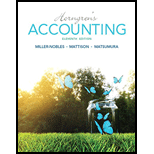
Horngren's Accounting (11th Edition)
11th Edition
ISBN: 9780133856781
Author: Tracie L. Miller-Nobles, Brenda L. Mattison, Ella Mae Matsumura
Publisher: PEARSON
expand_more
expand_more
format_list_bulleted
Textbook Question
Chapter 14, Problem S14.5SE
Determining bond amounts
Quick Drive-Ins borrowed money by issuing $4,000,000 of 4% bonds payable at 96.5.
Requirements
- How much cash did Quick receive when it issued the bonds payable?
- How much must Quick pay back at maturity?
Expert Solution & Answer
Want to see the full answer?
Check out a sample textbook solution
Students have asked these similar questions
General Accounting
Compute the company's degree of operating leverage
hi expert please help me??
Chapter 14 Solutions
Horngren's Accounting (11th Edition)
Ch. 14 - Prob. 1QCCh. 14 - Daniels's bonds payable carry a stated interest...Ch. 14 - Prob. 3QCCh. 14 - Prob. 4QCCh. 14 - Prob. 5QCCh. 14 - Prob. 6QCCh. 14 - Prob. 7QCCh. 14 - Prob. 8QCCh. 14 - Prob. 9AQCCh. 14 - 10B Hicks Corporation issued S500.000 of 5%,...
Ch. 14 - Prob. 1RQCh. 14 - Prob. 2RQCh. 14 - Prob. 3RQCh. 14 - Prob. 4RQCh. 14 - Prob. 5RQCh. 14 - Prob. 6RQCh. 14 - Prob. 7RQCh. 14 - Prob. 8RQCh. 14 - Prob. 9RQCh. 14 - Prob. 10RQCh. 14 - Prob. 11RQCh. 14 - Prob. 12RQCh. 14 - 13. What type of account is Premium on Bonds...Ch. 14 - Prob. 14RQCh. 14 - Prob. 15RQCh. 14 - Prob. 16RQCh. 14 - What does the debt to equity ratio show, and how...Ch. 14 - Prob. 18ARQCh. 14 - Prob. 19ARQCh. 14 - Prob. 20ARQCh. 14 - Prob. 21BRQCh. 14 - Prob. S14.1SECh. 14 - Prob. S14.2SECh. 14 - Prob. S14.3SECh. 14 - Pricing bonds Bond prices depend on the market...Ch. 14 - Determining bond amounts Quick Drive-Ins borrowed...Ch. 14 - Journalizing bond transactions Piper Company...Ch. 14 - Journalizing bond transactions Ogden issued a...Ch. 14 - Journalizing bond transactions Watson Mutual...Ch. 14 - Journalizing bond transactions including...Ch. 14 - Retiring bonds payable before maturity On January...Ch. 14 - Preparing the liabilities section of the balance...Ch. 14 - Prob. S14.12SECh. 14 - Prob. S14A.13SECh. 14 - Determining the present value of bond at issuance...Ch. 14 - Using the effective-interest amortization method...Ch. 14 - Prob. S14B.16SECh. 14 - Accounting for long-term notes payable...Ch. 14 - Preparing an amortization schedule and recording...Ch. 14 - Analyzing alternative plans to raise money AF...Ch. 14 - Determining bond prices and interest expense Nooks...Ch. 14 - Journalizing bond issuance and interest payments...Ch. 14 - Journalizing bond issuance and interest payments...Ch. 14 - Prob. E14.23ECh. 14 - Journalizing bond issuance and interest payments...Ch. 14 - Retiring bonds payable before maturity Parkview...Ch. 14 - Prob. E14.26ECh. 14 - Prob. E14.27ECh. 14 - Prob. E14.28ECh. 14 - Prob. E14.29ECh. 14 - Prob. E14A.30ECh. 14 - A Journalizing liability transactions and...Ch. 14 - Analyzing, journalizing, and reporting bond...Ch. 14 - Analyzing and journalizing bond transactions On...Ch. 14 - Analyzing and journalizing bond transactions On...Ch. 14 - Prob. P14.35APGACh. 14 - Determining the present value of bonds payable and...Ch. 14 - Determining the present value of bands payable and...Ch. 14 - Journalizing liability transactions and reporting...Ch. 14 - Prob. P14.39BPGBCh. 14 - Prob. P14.40BPGBCh. 14 - Prob. P14.41BPGBCh. 14 - Prob. P14.42BPGBCh. 14 - Prob. P14.43BPGBCh. 14 - Prob. P14AB.44BPGBCh. 14 - Describing bonds and journalizing transactions for...Ch. 14 - Decision Case 14-1 The following questions are not...Ch. 14 - Ethical Issue 14-1 Raffle's Kids, a nonprofit...Ch. 14 - Prob. 14.1FCCh. 14 - Prob. 14.1FSC
Knowledge Booster
Learn more about
Need a deep-dive on the concept behind this application? Look no further. Learn more about this topic, accounting and related others by exploring similar questions and additional content below.Similar questions
- What is the gross profit?arrow_forwardKelvin enterprises has the following reported amountsarrow_forwardDepartment A had 15,000 units in work in process that were 60% completed as to labor and overhead at the beginning of the period; 45,600 units of direct materials were added during the period; 42,500 units were completed during the period, and 11,000 units were 80% completed as to labor and overhead at the end of the period. All materials are added at the beginning of the process. The first-in, first-out method is used to cost inventories. The number of equivalent units of production for conversion costs for the period was ____ Units. Need Solutionarrow_forward
arrow_back_ios
SEE MORE QUESTIONS
arrow_forward_ios
Recommended textbooks for you
 Financial Accounting: The Impact on Decision Make...AccountingISBN:9781305654174Author:Gary A. Porter, Curtis L. NortonPublisher:Cengage Learning
Financial Accounting: The Impact on Decision Make...AccountingISBN:9781305654174Author:Gary A. Porter, Curtis L. NortonPublisher:Cengage Learning Cornerstones of Financial AccountingAccountingISBN:9781337690881Author:Jay Rich, Jeff JonesPublisher:Cengage Learning
Cornerstones of Financial AccountingAccountingISBN:9781337690881Author:Jay Rich, Jeff JonesPublisher:Cengage Learning

Financial Accounting: The Impact on Decision Make...
Accounting
ISBN:9781305654174
Author:Gary A. Porter, Curtis L. Norton
Publisher:Cengage Learning

Cornerstones of Financial Accounting
Accounting
ISBN:9781337690881
Author:Jay Rich, Jeff Jones
Publisher:Cengage Learning
Financial Accounting - Long-term Liabilities - Bonds; Author: Finance & Accounting Videos by Prof Coram;https://www.youtube.com/watch?v=_1fwsJIGMos;License: Standard Youtube License